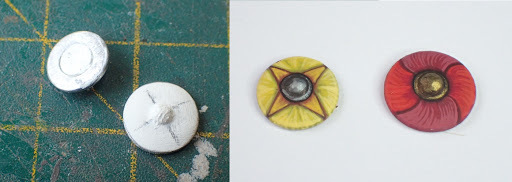Light at the end of the tunnel: my fourth and last large infantry unit of old 1980s Minifigs figures and the last one for which I have to hand paint the shields. My remaining two Auxillia Palatina units will be Legio Heroica figures and use Little Big Men transfers for the shields: oh happy day!
One thing I questioned before completing this unit was what standard bearer to choose. The old Asgard and Gladiator ranges have an aquila for legionaries whilst the Minifigs command group has a trumpeter and draconarius, unarmoured and dressed as their auxiliaries. Modern figure ranges seem to just have dracos for all infantry, with no distinction in dress or equipment for legions or auxilia. After reading around a bit, asking for advice and buying the relatively new Osprey "Roman Standards and Standard Bearers (2) AD 192 - 500" my understanding is that dracos were increasingly used for legionary sub-units but the emblem for the whole legion remained the Aquila. The book includes an illustration of a mid 4th C legion aquilifer from one of Julian's legions with a black bear pelt headdress, square base (perch?) for the eagle and gold coloured staff. Interestingly (or surprisingly) he wear leather armour. I based my Aquilifer on that illustration.
As previously, the trumpeter is a modified Minifigs Byzantine figure with a headswap. The Aquilifer and officer are Gladiator Miniatures - the latter with a new, larger shield made from brass and Milliput to match the Minifigs legionaries. As with the earlier units, I removed the helmet crests from some figures to get more variety, filed down some of the details of the legionaries sandals and disguised the rest with thick paint to depict them all in trousers.
The key thing with Late Roman armies is, of course, the glorious choice of shield designs. With the Lanciarii Gallienci Honoriani, Secunda Britannica and Petulantes Seniores already complete, the primary consideration was finding a shield design that would be significantly different but easy to paint. I settled on the Secundani Italiciani because it appeared to meet both of these criteria and I liked the idea of trying to make an interesting design from a white cross on a white background. I must admit though that I prefer the shields on the three earlier units
If you are tempted to hand paint the shields for this unit, my advice is to think again. I hadn't taken account of how hard it would be to reconcile making the inner circle (and hence the width of the crosses) big enough to paint with distinct colour graduations but leave enough length on the horizontal crosses for the three red dots - especially as the Minifigs shields aren't quite symetrical and there is less space on the figures left than the right. It took me several goes on some figures to get an acceptable result and even then I’m not really happy with most of them. If despite that, you do want to give it a go, here is the sequence I followed to get the basic features - the ‘white’ areas of the shields are my standard Vallejo triad of Khaki Grey, Iraqi Sand and Ivory. To give a different white, the helmet crests are London Grey, Light Grey and Foundation White.
I posted some photos and some of the text from my last unit on TMP and one of the comments was that these old 1980s Minifigs figures were a bit of a blank canvas. I hadn't really thought about it before myself but I think that hits the nail on the head and is a lot of what I like about these models. The overall proportions are quite good but the smooth surfaces give some space for the painter to create interest without being over constrained by exaggerated sculpted detail. This is especially so on the unarmoured figures with relatively large areas on the tunics where you can add or ignore shadows more or less as you like.











